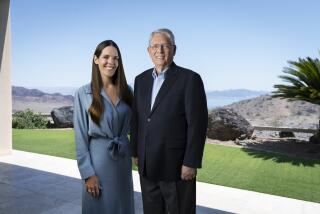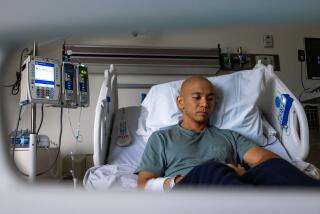Stranger’s Bone Marrow Forges ‘Family’ Bond : Transplants: Leukemia patient gets more than new lease on life--she also develops a fast friendship with her donor.
- Share via
In Rich Grant’s family, his chestnut-colored cowlick is known as the “Grant wave.” And those bushy eyebrows that snake across the 31-year-old’s forehead? Also from his father’s side of the family--the “mono-brow.”
This is how leukemia patient Kim Bubb, 38, says she recognized the stranger who saved her life, as soon as she laid eyes on him this summer. Bubb swears that she, too, inherited the Grant wave and the mono-brow--right after she got three pints of his bone marrow in a transplant April, 1993, at the City of Hope National Medical Center in Duarte.
Her doctor gently disputes that notion, attributing the changes to intense chemotherapy before the transplant. Bone marrow recipients get the donor’s blood and immune system, not the person’s looks or characteristics, said Dr. Pablo Miguel Parker.
But to Bubb, the looks go along with the kinship that has developed with her donor. She got more than just a second chance at life, she says. She got a fast friend.
The two first met at a City of Hope picnic for bone marrow transplant patients in July--he, a churchgoing, suit-wearing suburban family man; she, a blithe mountain-dwelling spirit in sweats and high-tops, who talks nonstop.
“He’s my hero, he’s my friend, he’s more than that,” said Bubb, who lives near Big Bear in Crestline. “I haven’t really found the right words. . . . We are on our way to becoming a little family.”
“Somehow, (she’s) more than just a friend,” said Grant, who lives in Mission Viejo with his wife and 14-month-old daughter. It’s “a family connection. There’s a definite bond there.”
Every few weeks, Bubb, who is now cancer-free, talks with Grant by telephone. In October, they gave a speech together to a women’s group in Crestline about the importance of blood donations for bone marrow testing.
Afterward, Grant dropped by her house to visit. As a holiday present, Bubb recently gave Grant--who has a sweet tooth--a homemade fudge-covered apple wrapped in red cellophane paper.
Bone marrow recipients sometimes don’t meet the strangers who save their lives because of a privacy desire on either side or because they live far away from each other, said Jennifer D. Caliandro, a spokeswoman for the National Marrow Donor Program in Minneapolis.
The national registry does not keep statistics on how many donors and recipients meet, she said. Under registry rules, donors and recipients must wait one year--the patient’s critical recovery period--before contacting each other.
Bubb could not wait. She thought about her donor continually.
In April, on the day that the waiting period expired, she filled out paperwork to hook up with her donor. A couple of weeks later, she got his name and office phone number from the registry.
“Hi, Rich,” she said nervously into his answering machine. “My name is Kim. You don’t know me, but you are my hero. You are the man who saved my life.”
He called back that night. They talked for nearly an hour about the fate that had brought them together. Before all of this began, Bubb was living in her dream place in Phoenix. She had planned to live forever in her three-bedroom, ranch-style home with a pool, fireplace and huge back porch. She worked as an office manager for a paint and body shop.
Life was peachy for the Louisiana native.
Then, the night sweats started. Heavy nosebleeds. Fatigue.
Early menopause, she thought. She was wrong.
In July, 1991, she was found to have chronic myelogenous leukemia, a life-threatening cancer. Her doctor put her life expectancy at three to five years and said only a bone marrow transplant could save her.
I’m dying, Bubb thought. This is judgment day.
Bubb read a three-page pamphlet on bone marrow transplants that said there is only a one-in-20,000 shot of finding an unrelated donor. And even with a transplant, survival rates hovered in the 30% to 60% range.
The odds were hopelessly against her, thought Bubb, who had considered herself so unlucky that she had never even bought a lottery ticket.
Six of her relatives got their blood tested, but none of them had matching bone marrow.
In November, 1991, Bubb thought her luck had changed. It had--for the worse.
She got a call saying that the national registry had found a match, a 36-year-old woman with the same bone marrow makeup as hers. Bubb packed her bags, ready to go to the hospital at a moment’s notice. Two weeks later, her hopes crashed. The donor had backed out, for unknown reasons.
More bad news that week: Bubb, who had quit work in August because of her failing health, also lost her insurance.
“I had a donor, I had insurance . . . she changed her mind. It was all bam bam bam bam bam! My one-in-20,000 chance just passed in front of my face, and I was going to die.”
She decided to move to California, so she could receive treatment at the City of Hope, the country’s second-largest bone marrow transplant center after the Fred Hutchinson Cancer Research Center in Seattle.
In California, Bubb was able to get Medi-Cal and Medicaid, and live near the mountains in tiny Crestline. In May, 1992, Bubb and her best friend, Debbie Young, moved to a rented wood-frame cottage.
Bubb is a stubborn sort, a high-spirited prankster whose doctor peers around the corner when she’s around, knowing she might ding him with a flying rubber glove. She is a fighter, taping most of her doctor visits so she can be sure to remember his advice. But she is also a realist.
“If I was going to die, and I had to move, by golly, I wanted to be somewhere where I wanted to go, where I look out the window and I see beauty,” she said.
The clock was ticking. Without a donor, she would die.
To pass the time, she started to fish, rising at 4 a.m. to beat the locals to the best fishing holes at nearby Lake Gregory.
“I wasn’t looking for the phone call any more (about a donor). . . . My dying was for the best, I had convinced myself of that.”
And then in December, 1992, another call came. There was a match.
Even now, her eyes water, just thinking about it.
“Do you know how miraculous it is for me to have another donor match?” she asked. “I am meant to be here.”
On March 29, 1993, Bubb was admitted to the City of Hope for a bone marrow transplant.
First, she underwent four days of intense radiation and chemotherapy to kill cancerous cells, a process that also destroys bone marrow function. Bone marrow is the tissue that manufactures parts of the blood and immune system, including white blood cells, which fight off infection.
After a transplant, the new marrow restores the patient’s damaged bone marrow and immune system. The makeup of the donated marrow must match, or the patient’s body will reject it.
With no immune system, Bubb waited in isolation for her new marrow. The donated marrow--a red, jelly-like fluid--is transfused directly into the bloodstream, much like a blood transfusion.
Right before the transplant, a nurse handed Bubb her donor’s bone marrow, in three bags, to hold for a precious second.
“I held my life in my hands,” Bubb said, shaking her head in wonder. “It was a feeling you cannot even imagine.”
Bubb’s transplant took six hours. Seven weeks later, she went home.
Meanwhile, she wondered about her donor, who she knew was a young American male. She imagined him as big, because he seemed to have a lot of bone marrow. And he must be hairy, she thought, because her own hair grew back thicker after the transplant.
She didn’t want to refer to him impersonally as her “donor.” So she made up a name for him--”Dave.”
“So, for a year,” Bubb said, “it was ‘Dave and I.’ ”
*
In college, Rich Grant got into the habit of donating blood. He was an economics major at UC Davis, apt to drop into the campus blood center for the free doughnuts and coffee as much for the civic duty.
After college, he worked for Wells Fargo’s commercial banking department, before joining Heller First Capital Corp. in August, 1990.
In December, 1992, Grant got a memo at his San Francisco office. The memo suggested that employees consider testing their blood for the national bone marrow registry.
He signed up. He had no idea what a bone marrow transplant involved.
In February, 1993, he got a call on his office’s automated answering system from his local blood center. His bone marrow was a potential match with that of a dying woman. After more tests, there was no doubt. He matched.
At the blood center, officials met with Grant and his 30-year-old wife, Colleen, and explained the simple surgical procedure. Under general anesthesia, 2% to 5% of the donor’s liquid marrow is extracted from the hip area through a special needle and syringe.
The donor stays in the hospital overnight for observation. After the procedure, the donor’s lower back area is sore. But the pain is gone within a week, and the donor’s marrow replenishes itself within a few weeks.
“At no point along the way did I ever say, ‘Am I doing the right thing?’ ” Grant said. “It was really a very easy decision to make--to save someone’s life.”
More to Read
Sign up for Essential California
The most important California stories and recommendations in your inbox every morning.
You may occasionally receive promotional content from the Los Angeles Times.










